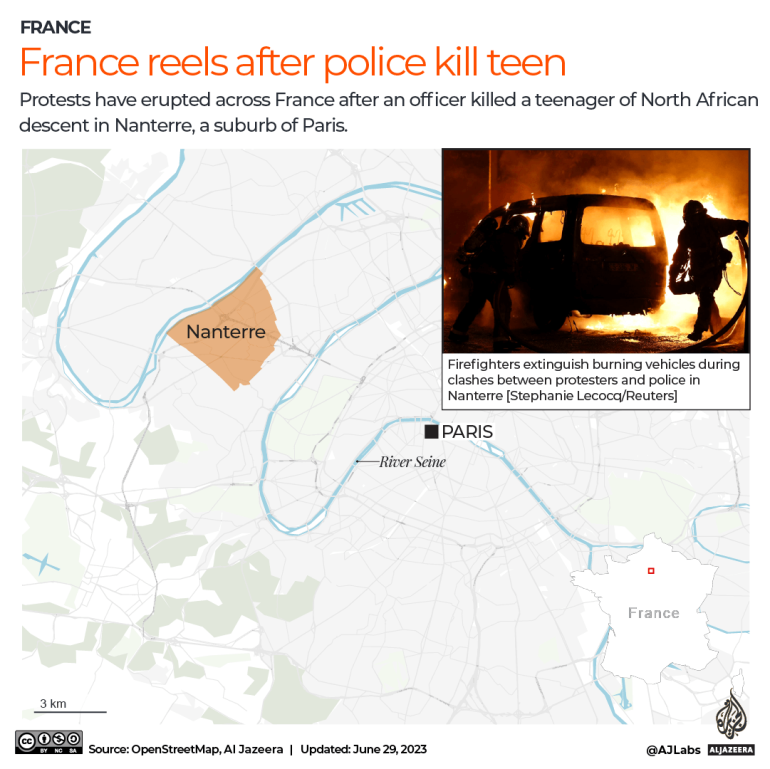France police shooting prompts unrest: All you need to know
Clashes erupt in several French cities after the police killing of a teenager, prompting the mobilisation of 40,000 officers.

More than 40,000 police officers have been mobilised across France as the government tries to contain growing anger after a police officer killed a teenager.
The 17-year-old, known as Nahel M, was driving a rental car in the western Paris suburb of Nanterre on Tuesday morning when police pulled him over during a traffic check for breaking several road rules.
Keep reading
list of 3 itemsFrance knife attack suspect charged with attempted murder
France braces for further protests after police kill teenager
What started the protests in France?
Police said that the teenager, who was of North African descent, was driving his car towards them, but footage emerged contradicting their narrative. A video circulating on social media showed a police officer pointing his weapon through the window and appearing to fire at point-blank range.
Nahel M died shortly afterwards from his wounds, according to the local prosecutor.
Too young to hold a full driving licence in France, the 17-year-old was driving illegally, a source familiar with the investigation said. The Nanterre prosecutor said he was known to police for previously failing to comply with a traffic stop order.
Al Jazeera’s Natacha Butler, reporting from Nanterre, said that protesters, mainly young men, have thrown fireworks at police officers during overnight riots.
“This is a suburb like any other where people have to go to work and school, and the majority of people aren’t taking part in this violence,” she said.
“They don’t want to see the violence but they are torn, everybody here understands the anger that is simmering. Nearly everyone saw that video,” Butler added.

Where are people protesting?
The protests started in Nanterre, but anger spilled onto the streets in the northern city of Lille and in Toulouse in the southwest.
There was unrest in Amiens and Dijon, as well as in numerous districts throughout the greater Paris region, the authorities said.
How are authorities responding?
Interior Minister Gerald Darmanin said at least 180 people were arrested during a second night of unrest.
He also said that 40,000 police officers – 5,000 in Paris alone – were deployed on Thursday across the country – nearly four times more than the previous evening.
“The response of the state must be extremely firm,” Darmanin said.
Darmanin and Prime Minister Elisabeth Borne ruled out declaring a state of emergency for now.
What was Macron’s reaction?
French President Emmanuel Macron has described the killing as “inexcusable”, but also condemned the sometimes violent unrest, pleading for calm as justice takes its course.
He has also convened a crisis meeting with senior ministers, denouncing the shooting and the riots.
“The last few hours have been marked by scenes of violence against police stations but also schools and town halls, and thus institutions of the republic and these scenes are wholly unjustifiable,” Macron said as he opened the emergency meeting.
What happens next?
The French police officer who killed Nahel M was on Thursday placed under formal investigation for voluntary homicide.
The government raced to ease public anger and protesters planned a tribute march.
How rare is police brutality in France?
Tuesday’s lethal shooting was the third of its kind this year, down from a record 13 people who were killed after not complying with a traffic stop in 2022, according to a police spokesperson.
There were three such killings in 2021 and two in 2020, none in 2019, and six in both 2018 and 2017, according to a Reuters news agency tally, which shows most victims since 2017 were Black or of Arab origin.
France’s human rights ombudsman opened an inquiry into the death on Tuesday, the sixth such inquiry into similar incidents in 2022 and 2023.
When is a police officer allowed to shoot?
Since 2017, France’s legislation has allowed police to use their firearms in five different scenarios:
- When their life or physical safety, or the life of another individual, is put at risk;
- When a place or people under their protection come under attack;
- When they are unable to prevent someone likely to threaten their life or physical safety, or other people’s, from fleeing;
- When they are unable to stop a vehicle whose driver has ignored an order to stop and whose occupants are likely to pose a risk to their life or physical safety, or other people’s;
- If there is reason to believe it will prevent murder or attempted murder.
What do critics say?
Rights groups have criticised the 2017 law, saying it dangerously broadened the legal framework for when an officer can use a firearm.
Fabien Jobard, a researcher at the Sociological Research Centre for Law and Criminal Justice Institutions (CESDIP), had previously told Reuters that there were ambiguities in the law.
“This law confused very clear texts stating that a [police officer] cannot use their firearm unless it is to protect their life or the life of another,” Jobard said.